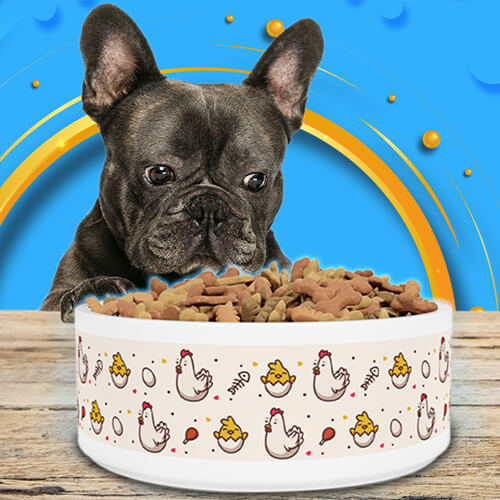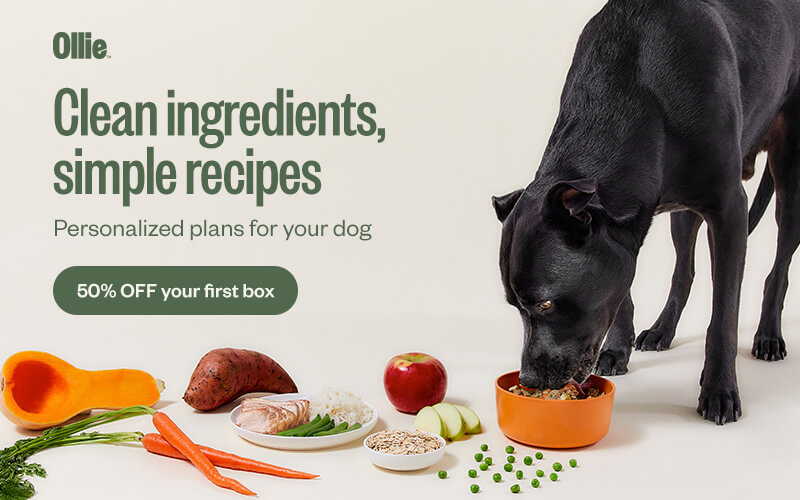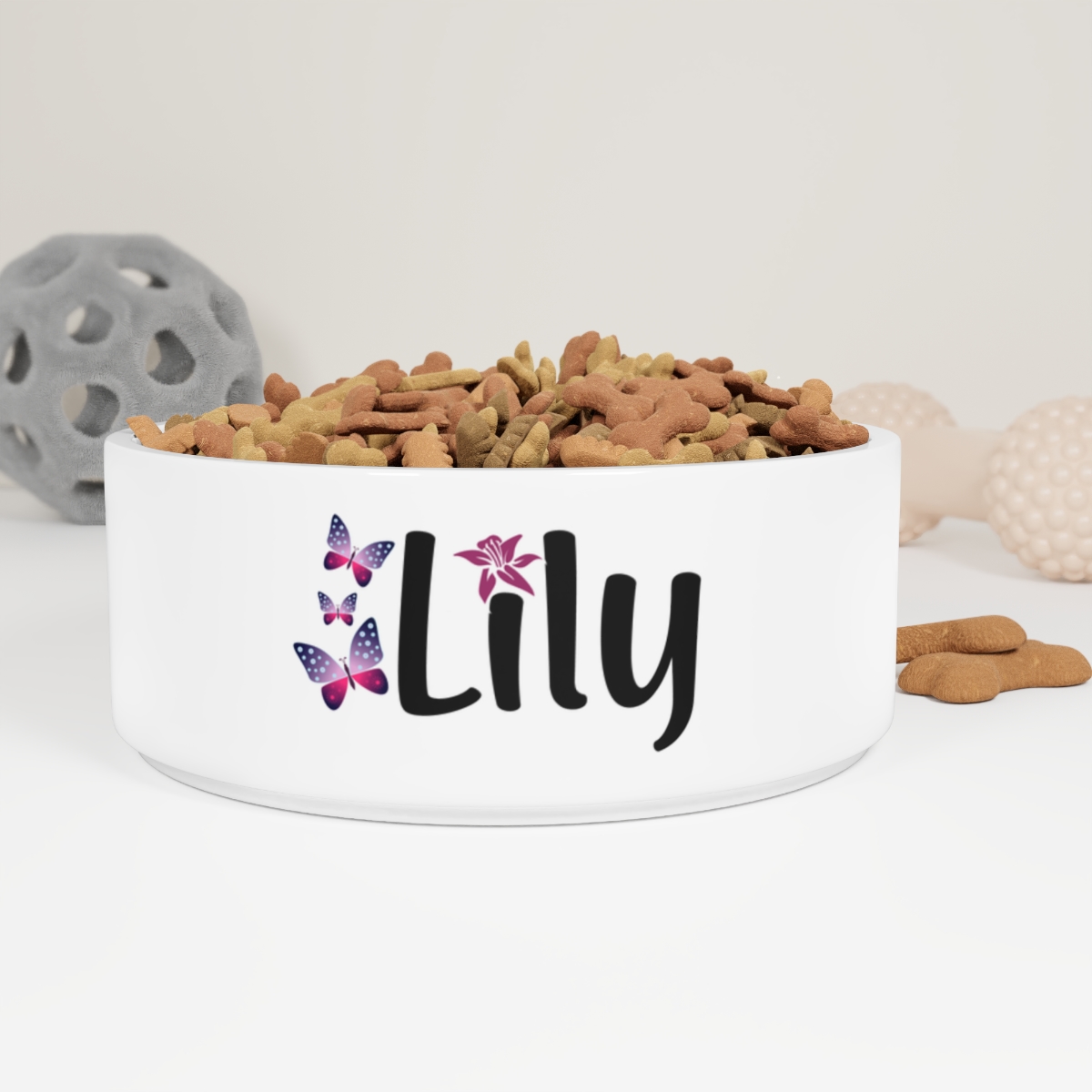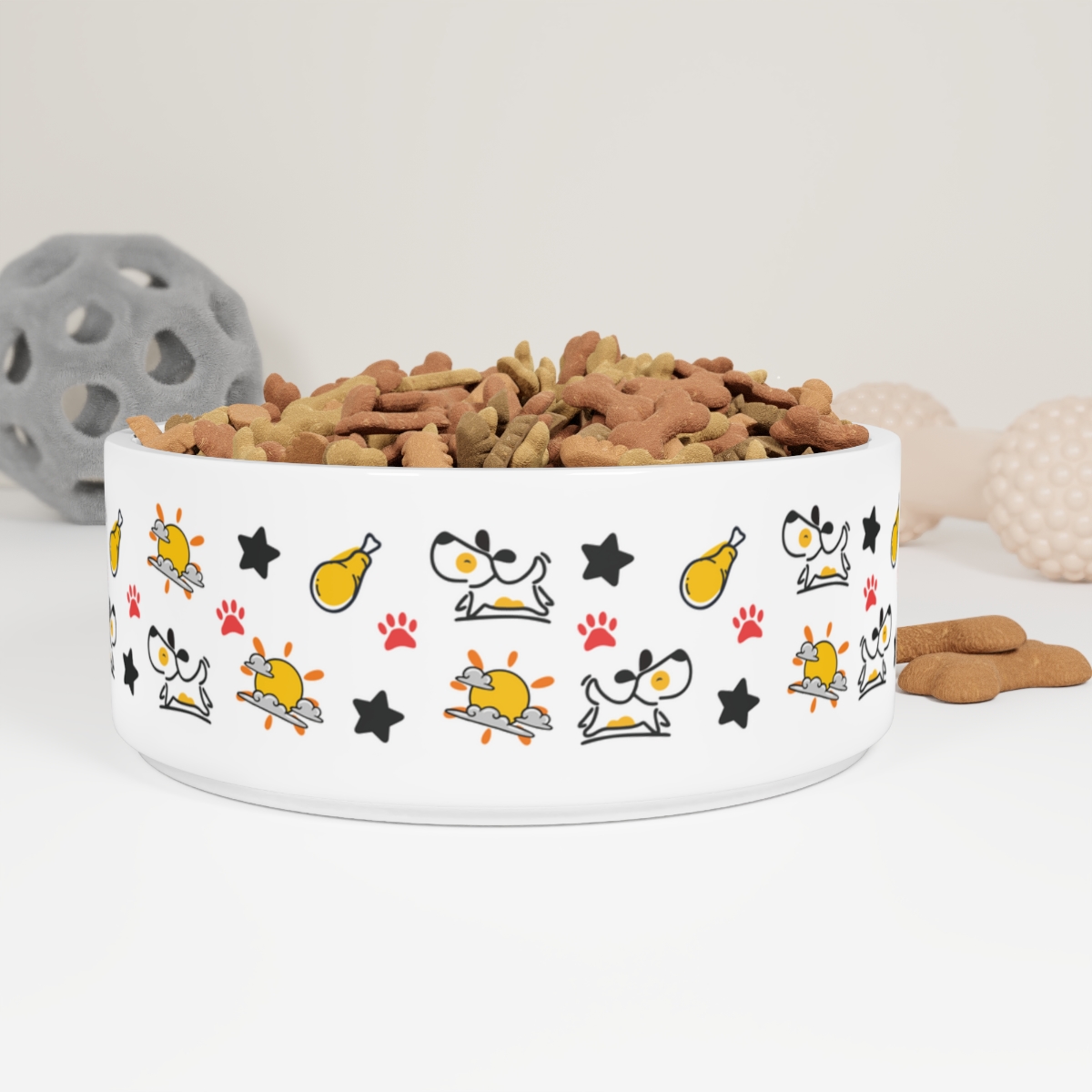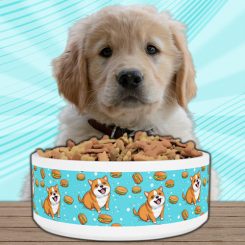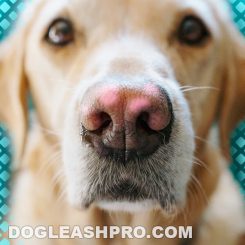
Why Does My Dog Nudge His Food Bowl Before Eating? Dogs can nudge their food bowls for various reasons depending on their health and circumstances. The most common reasons for such behavior include curiosity, instinct, anxiety, or routine. Other possible causes are attention-seeking behavior, discomfort, and visual or dental problems.
Has your canine taken to nudging its food bowl at chow time? If yes, you can relax because this behavior isn’t uncommon in dogs. Your pet can paw its food for a variety of reasons, and if you’re interested in learning more – this article can help!
If you’ve been wondering why your dog pushes his food with his nose, find a comfortable seat and stick with us as we break down all possible explanations for this distinct doggy behavior. There’s also a bonus related questions section towards the end for the more inquisitive minds.
RECOMMENDED: Are Ceramic Bowls Safe For Dogs?
Table of Contents
Dog Pushing Food Bowl Away With Nose: Unpacking the Mystery!
It’s possible your pet is trying to tell you it’s time for a change. Stainless steel bowls may last longer, but ceramic bowls offer neutrality when it comes to odor and taste.
Besides that, pet parents don’t have to worry about harmful metals or chemicals leaching into their fur baby’s food.
Also, ceramic bowls help keep your canine’s food at a comfortable temperature, which helps tempt your pet into eating during hot summer days.
I Noticed My Dog Pushing Food Bowl Away With Nose And Not Eating! Why?

Is your dog pushing the food bowl away with his nose and not eating? You’re in luck because we know why. Pawing, nudging, or trying to bury food is quite common in the doggy community.
Dog nudging with nose, aka nosing, can occur due to various reasons.
Here’s a quick lineup of ten reasons that every dog parent should know if their dog is pushing a food bowl with his nose. Ready? Here goes.
1. Curiousness
Sure, cats and curiosity go hand-in-hand. But that doesn’t mean your fur-ever friend isn’t just as inquisitive.
2. Natural Tendency
At times, you can chalk up nosing to dog rituals before eating. Believe it or not, some behaviors are hardwired into animals by nature.
3. Anxiety
Animals can express displeasure or nervousness in a number of ways. Nosing is one of the forms through which dogs express stress.
4. Routine
Has your furry friend always nudged his food bowl whenever you fill it with yummy stuff like Ollie Fresh Dog Food? If yes, nudging is just a plain ole’ habit for your little pup.
5. Drawing Attention
You can expect your canine to behave funny when he wants your attention. Nudging the food bowl can be a great trick if your pet wants your engagement.
6. Discomfort
If your fur baby is feeling down and out for whatever reason, he will find a way to relay his discomfort. Nudging or pawing the food bowl with other worrying signs like inappetence or lethargy can mean your pet might be sick.
7. Vision Problems
No matter how delicious the meal, you can expect your pup to paw at the food bowl if he is experiencing vision problems.
READ NEXT: How To Soften Dog Eye Boogers?
8. Dental Problems
There’s a reason why experts insist on oral hygiene for canines. Gum infection or swelling can make eating uncomfortable, leading to your pet nosing the bowl.
9. Dislike
If you’ve recently switched your dog’s pet food, the pawing or nudging of the food bowl can indicate aversion.
10. Boredom
Some canines are quicker to lose interest than others. If you’ve been neglecting your furry pal’s exercise or playtime, nosing can be a good sign of boredom.
Letting them out in the backyard can offer a refreshing change of pace and exercise. But safety is paramount.
Make sure your backyard is secure with a sturdy physical fence to prevent unexpected escapes.
If a traditional fence isn’t feasible per zoning regulations, you’ll want to consider a wireless dog fence. An invisible dog fence can help maintain boundaries just like a physical fence and keep your pup safe while they play, run, and exercise.
Why Does My Dog Nudge His Food Bowl With Food In It?
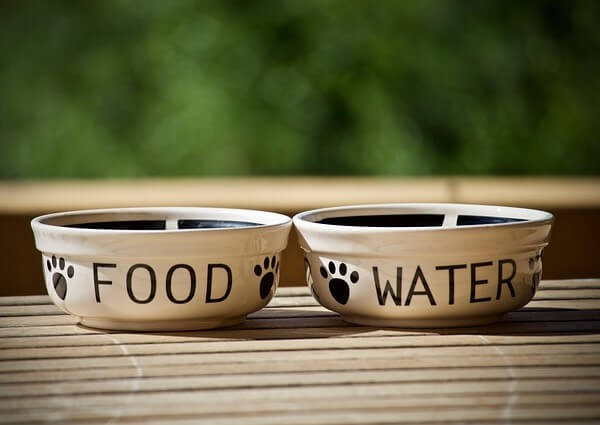
There may be several factors contributing to such behavior.
First, it’s essential to understand that dogs have highly developed senses, especially their sense of smell. So, nosing the food bowl can simply be your pet’s attempt at figuring out what’s for lunch or dinner.
Canines can be very curious about food because they’re opportunistic eaters. It’s normal for them to want to discover the texture or aroma of food to understand what they’re eating.
According to the article titled “Food and Food-Odor Preferences in Dogs: A Pilot Study” on National Library of Medicine, “In dogs, olfaction is believed to play an integral role in the sensory experience of eating and food choice. Little information, however, has been published about what odorants dogs naturally find hedonically appealing and whether such odors enhance palatability and food consumption.” (Source)
Therefore, nudging the food bowl can also be a type of exploration exercise.
Dogs often use their paws or noses to interact with their environment and gather information about objects. By pawing the bowl, your pet may be trying to understand the contents of the food bowl better.
Conversely, in some cases, nosing can be a sign of food dissatisfaction or boredom with diet. If your fur baby consistently exhibits such behavior, you might experiment with their food choices to see if they prefer a different brand or flavor.
Also, consulting the vet might help you better understand your canine’s dietary preferences.
Nudging behavior is generally harmless and can also be seen as a natural part of your dog’s mealtime routine. If it doesn’t appear to be causing any issues and your pet is eating well, it’s nothing to worry about.
DON’T MISS: Why Do Dogs Play With Their Food? 15 Reasons Why!
Why Does My Dog Nudge His Food Bowl: Analyzing The Behavior
Thus far, we’ve focused on the causes of nosing. But what kind of behavior is linked to dogs nudging their food bowl? Let’s find out why canines behave this way.
1. Curiosity
When it comes to canine inquisitiveness, their keen senses primarily motivate their behavior. Doggie senses are pretty sharp in terms of hearing, sight, and smell. They can pick up sounds, scents, and noises humans can’t.
So, it’s only natural that canines are inherently curious. In fact, experts state that curiosity is the sign of a healthy, well-adjusted pup. The safer your fur baby feels in its environment, the more likely its desire for exploration.
How does that translate to food bowl that a dog nudges with his nose?
That’s simple.
If your pet doesn’t show worrying red flags like whining, excessive licking, and lack of appetite, you don’t have to stress about food bowl nudging. Because chances are, you just have a very inquiring fur baby on your hands.
2. Instinct
Instinct isn’t an easy concept to explain. It’s an inherent trait that humans and animals are born with. More often than not, instinct is linked to survival. Think of it as mother nature’s way of safeguarding a species.
So, when a dog nudges his food bowl, what instinct is driving it?
Here’s where things get a little tricky because it could be one of two things.
For example, canines inherit their love of nosing from their ancestors, who buried or covered their food to keep it safe from other predators or to hide their scent.
You should note that if your fur baby is nudging because of instinct, it has nothing to do with your caretaking capacity. It doesn’t mean your pet is trying to stash food because you’re not feeding him well or your pet doesn’t feel safe at home.
It’s an impulse that canines can’t override. A safety measure, if you will, in case they have to survive on their own. If your dog is trying to bury food by nudging the bowl, it simply means your pet inherited more than just looks from its ancestors.
READ ALSO: How to Get Your Dog to Eat When Sick
3. Anxiety
Anxiety or nervousness can have several triggers in canines. Being left alone for too long, past trauma of being mistreated, relocation, and even excess energy.
Moreover, pups have unique personalities, so they have different thresholds for issues like nervousness. In short, what affects one canine may not have the same effect on another.
The good news is that pet parents can pick up signs that indicate their pets are disturbed by something.
Symptoms of canine anxiety can include panting, pacing, drooling, and becoming reclusive or aggressive.
If you notice your pet has picked up the habit of nosing out of nowhere, the first order of business is to find the change that sets off your fur baby’s nerves. Once you fix the problematic shift, you’ll notice your dog giving up the nudging habit on its own.
RELATED: How Long Can A Dog Go Without Eating?
4. Routine
Uncertainty affects all living things, and dogs are no different. A canine with a daily routine thrives because HE knows exactly what to expect and when.
Conversely, you can expect distress when something interferes with a pup’s schedule.
Routine or its disruption is related to anxiety in a way because dogs don’t deal with changes very well. They generally have to be eased into new situations. For instance, actions like your dog nudging a food bowl with his nose can be related to a change in their life.
It could be anything like changing homes, a new pet, or even changing the location of your fur baby’s food bowls. If your pet picks up the food bowl nudging habit after such an event, your dog’s anxieties are likely playing out.
RECOMMENDED: Puppy Has Diarrhea But Still Playful
5. Attention-seeking
Do you have a canine diva on your hands that likes vying for your attention? If yes, there’s no significant cause for concern. Canines typically seek out their parent’s attention for three reasons: excess energy, boredom, or playtime.
If you leave your fur baby on his own devices for too long, he will be bored. If the pattern continues, canines can develop destructive behaviors.
That’s why exercising your pet according to his set requirements is vital. A busy dog is a happy dog.
CHECK OUT: How Far Can French Bulldogs Walk? (Incl. How Long & How Often)
If your furry pal has taken to bowl nudging recently, ask yourself if he could be under-exercised or bored. It can also be that your dog wants your company and attention.
6. Discomfort
Animals react to discomfort differently. Some act withdrawn like cats, while others try to communicate their pain through actions. That’s why it’s not strange for dogs to start nosing or pawing bowls if they feel under the weather.
If your pet has been acting lethargic, seems distant, or is whining on and off, think of the bowl pawing as a cry for help.
In such events, it’s best to book a visit to the vet as soon as you can to help your fur baby feel better.
7. Vision Problems
As it is with discomfort, if your pet is experiencing vision issues, you can expect to act differently.
For example, if your furry friend has developed cataracts, your dog may be nudging the bowl to understand how far it is or how it is positioned. The bowl nudging, in this sense, is born out of necessity.
RECOMMENDED: Dog Losing Hair Around Eyes? (9 Top Reasons + What To Do)
8. Dental Problems
Dental problems can be a literal pain for canines. Not just literally but figuratively. Since dogs are generally happy eaters, going off food because of a tooth infection or swelling gum isn’t easy.
When dogs nudge the food bowl in these situations, it’s partly out of dissatisfaction and need. Your canine is likely trying to find a way to consume his food without suffering from annoying dental pain.
You may be interested in: German Shepherd Teething Stages, Age & Timeline of Baby Teeth
9. Aversion
We’ve already talked about how dogs have a strong sense of smell. If you place your pet’s favorite treat in front of him, it’ll likely be devoured within minutes.
However, if you give your fur baby something that doesn’t appeal to him smell or taste-wise, you can expect your pooch to try and nudge the bowl away or knock it over.
In which case, the message should be loud and clear: try another brand of dog food like the Ollie Fresh Dog Food.
10. Boredom
Dogs and boredom are never a good combination. Not for you or your pet. Being left alone, under-exercised, or ignored can lead your fur baby to develop what may seem like weird behavioral characteristics.
Things can start off with food bowl nudging and progress to full-blown destructive behaviors like chewing furniture or scratching floors.
You may also like: Why Does My Dog Lick My Arm So Much?
If you’ve been coming home to ripped tissue paper rolls, gutted pillows, askew rugs, and bowl nudging conduct, give your pet some TLC and interactive toys or dog bones as soon as possible.
Why Does My Dog Push Her Food Bowl Around?
From curiosity to boredom, the dog nudging food bowl problem can have many potential triggers.
If you’re interested in understanding why your dog pushes food bowl with nose, you might want to pay attention to what we’re about to discuss next.
Material Preferences
When choosing your pet’s food bowl, paying attention to materials is essential. For instance, you’ll run into steel, ceramic, plastic, and silicone bowls.
Ceramic bowls are heavy, but they come with a smooth surface that’s easier to clean.
Another thing to note about these bowls is that they’re chemical-free.
If you’re unable to find ceramic bowls, steel bowls can work as an alternative. These bowls offer durability and hygiene. However, since these bowls are lightweight, they might be suitable for messy eaters.
Plastic is generally not recommended because it can leech chemicals in your pet’s food and water, resulting in health problems.
Position Preferences
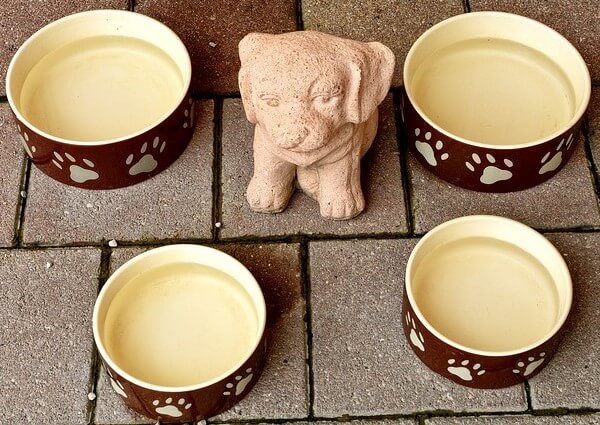
Why is the correct placement for your pet’s food and water bowl important?
If your dog is a messy eater, you may find splatters on walls and spills on the floor, leading to lots of cleanup.
When picking a place for your pet’s chow area, make sure there are no breakable objects around.
Place a wide silicone mat underneath the bowl to keep your floors safe from spills.
It’s also a good idea to leave a wide gap between the bowls and your walls to avoid splatters and stubborn debris.
If your fur baby is in his golden years or has back concerns, you can use a platform on the floor to raise the height. This way, your pet won’t have to bend over too much to eat or drink.
However, according to Dr. Louise Anne Buckley of The University of Edinburgh, she noted the following:
“One study found a significant effect of feeder height, with large and giant breeds fed from a raised feeder being at an increased risk of GDV floor fed dogs. Large breed dogs were more likely to develop a GDV if fed from a bowl ≤ 1 foot tall, whereas giant breed dogs were more likely to develop a GDV if fed from a bowl > 1 foot tall. No studies found that feeding from a raised feeder reduced the risk of GDV relative to feeding from the floor. Therefore, the safest option in the absence of further evidence is to advise that owners of ‘at risk’ dogs feed from a feeder on the floor.”
Since all dogs are different, it’s best to consult with your vet to find the best bowl position for your pup.
Why Do Dogs Push Their Food Bowl With Their Nose: Specific Scenarios and Their Implications
Dogs pushing their food bowl with their nose can be due to various scenarios, each with distinct implications. Here’s how.
Exploration
Sometimes, canines use their noses to interact with objects in their environment, including food bowls. This behavior might reflect curiosity and playfulness.
However, this playfulness might require monitoring, lest your fur baby create a mess.
Instinctive Behavior
If your dog is pushing the food bowl around, it might be trying to hide some food for snacking purposes later on.
If that’s the case, investing in a sturdy ceramic bowl with a silicon mat is best to keep your fur baby from turning the bowl over.
Attention-Seeking
Dogs are social animals, and pushing the bowl can be a way to solicit attention. If your dog has learned that this behavior gets a response, it might continue to do so to grab your attention.
Discomfort
If your pet has been bowl nudging consistently, it might be expressing dissatisfaction with the food or discomfort related to dental or gastrointestinal issues.
In such situations, monitoring your canine’s overall eating habits and consulting with a vet can be crucial.
Understanding the context of your pet’s behavior can help you determine the cause behind nudging bowls.
Adjusting the bowl or changing the pet food brand might address these concerns and make mealtime enjoyable for your furry pal.
Why Dogs Push Food Bowl With Nose: Addressing Persistent Behavior
Understanding why dogs push food bowl with nose can help dog owners address the situation with greater care and success. If your pet persistently pushes their food bowl with their nose, addressing the behavior is essential to ensure a smooth mealtime routine.
First, rule out the chances of any physical discomfort or dental issues that might make eating difficult. Once you’re sure your pet’s health isn’t the problem, look for clues to help you identify what is.
Ensure the eating bowl is clean, and the food is appropriate for your dog’s taste and dietary needs.
If you suspect bowl nudging is for attention-seeking, consider not reacting to the behavior and only rewarding calm conduct during mealtime.
If you’re a first-time dog owner, consulting an animal behaviorist might help.
So, Is It Normal For My Dog To Nudge Food With His Nose?
Food nosing, also known as dog rooting with nose, also known as food bowl nudging, is generally not a cause for concern. Dogs may do this out of curiosity, playfulness, or to gain their owners’ attention.
However, if the habit becomes excessive or is accompanied by other signs such as lethargy or inappetence, it’s best to consult a vet or a professional dog trainer for more guidance.
Why Does My Dog Nudge Her Food Bowl: Decoding the Nudging Behavior
Many pet parents ask themselves the same question. Thankfully, we’ve lined up some answers to help guide you about this particular canine conduct.
So, Should I Stop My Dog From Pushing Food Out Of Its Bowl?
Whether or not you should stop your furry pal from nudging the food bowl depends on the reason behind the behavior and its impact.
If your dog occasionally pushes food but eats normally, there’s no cause for concern. However, if the habit is persistent, consult a vet.
So, Why Does My Dog Nudge His Food Bowl Before Eating?
Dogs can nudge their food bowls due to several reasons. Some causes are harmless, such as curiosity or instinct, while others require professional help, such as discomfort related to a health problem.
Pet parents should prioritize understanding why their pet is nudging or pawing the food bowl. That’s the first step to solving the problem successfully. Once you’re sure of the trigger behind your fur baby’s bowl-nudging behavior, you can work on resolving the problem.
Related Questions
Dogs often play with their food bowl before eating due to curiosity or a playful disposition. It’s usually harmless unless the habit is persistent or accompanied by signs like listlessness, lack of appetite, or whining.
Canines are curious animals with a strong sense of smell. They like sniffing their food to discover their meal and if it’s to their liking.
Your dog may move his food to get better access. At times, when the dog bowl is too small or too large, your pet may find eating comfortable a challenge.
If your dog pushes its food bowl away after sniffing it, there’s a good chance it doesn’t like or want to eat it.
DISCLAIMER: THIS WEBSITE DOES NOT PROVIDE MEDICAL ADVICE
The information, including but not limited to, text, graphics, images and other material contained on this website are for informational purposes only. No material on this site is intended to be a substitute for professional veterinary advice, diagnosis, or treatment. Always seek the advice of your veterinarian or other qualified health care provider with any questions you may have regarding a medical condition.
Resources:
AKC: https://www.akc.org/expert-advice/training/attention-seeking-behaviors-in-dogs/

With over five years of specialized experience as an animal writer, my expertise lies in dog nutrition, health, behavior, grooming, and training. I am dedicated to delivering helpful and informative content that caters to the well-being of our furry friends. My primary goal is to empower pet owners with knowledge and ensure our canine companions thrive in health and happiness. In my free time, I love volunteering at local dog rescue centers.
